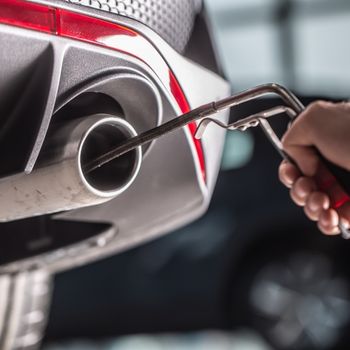 Your vehicle’s exhaust system plays a crucial role in keeping you safe by reducing harmful gases like carbon monoxide. If something goes wrong—like a leak or damaged part—this can put you at serious risk. Understanding how these issues happen and what to look for can help protect you and your passengers.
Your vehicle’s exhaust system plays a crucial role in keeping you safe by reducing harmful gases like carbon monoxide. If something goes wrong—like a leak or damaged part—this can put you at serious risk. Understanding how these issues happen and what to look for can help protect you and your passengers.
Knowing the risks and taking action early can prevent dangerous situations. Let’s take a closer look at how car exhaust systems work and what you should watch out for.
How Cars Minimize Carbon Monoxide Emissions
When your engine burns fuel, it produces a lot of carbon monoxide—up to 30,000 parts per million (ppm). That's extremely dangerous if released directly into the air. To reduce this, cars are equipped with a catalytic converter, which helps convert most of that CO into less harmful carbon dioxide before it exits through the tailpipe.
Without a properly functioning catalytic converter, the level of carbon monoxide could be dangerously high. Even small leaks in the exhaust system can cause some of this gas to escape before it reaches the converter, increasing the risk of exposure inside the car.
How Carbon Monoxide Can Get Into Your Car
It’s not just about leaving your car running in a closed garage. Carbon monoxide can also enter your cabin through other means, such as:
- A damaged or rusted exhaust system
- Holes in the body or floor panels
- An open trunk or tailgate
- Issues with the HVAC system
If any of these happen, carbon monoxide can seep into your car and affect everyone inside. This is especially dangerous because CO has no smell or color, so you might not even know it's there until it's too late.
Common Causes of Exhaust Leaks
Several factors can lead to an exhaust leak. One of the most common is rust and corrosion. If your car isn’t driven often or only on short trips, moisture can build up in the exhaust system, leading to rust over time. This can create pinholes or cracks that let fumes escape.
Other causes include a faulty catalytic converter, broken gaskets, or damaged pipes. If the exhaust system isn't sealed properly, carbon monoxide can travel into the car through the vents, floor, or even the dashboard.
Open Trunk or Tailgate
Leaving the trunk or tailgate open while driving might seem harmless, but it creates a direct path for exhaust fumes to enter your car. Especially if you're driving in traffic or in a tight space, this can increase the amount of CO inside your vehicle.
HVAC System Vulnerabilities
The heating and cooling system draws in outside air and recycles cabin air. If there’s a leak in the exhaust system, this can pull in carbon monoxide from outside and circulate it inside your car. It’s a silent threat that can go unnoticed until symptoms appear.
Recognizing the Signs of an Exhaust Leak
Since carbon monoxide is odorless, it's hard to detect without proper tools. But there are signs you can watch for:
- Smelling exhaust fumes inside the car
- Feeling dizzy, tired, or nauseous while driving
- Experiencing headaches or difficulty concentrating
- Noticing a hissing sound from under the car
- Seeing visible damage or rust on the exhaust system
If you notice any of these, get out of the car immediately and seek medical attention. Even short exposure can have serious health effects.
Preventing Exhaust Leaks and Carbon Monoxide Exposure
To stay safe, make sure to have your exhaust system checked regularly. A professional inspection every couple of years can catch issues before they become dangerous. You should also:
- Avoid running your car in enclosed spaces
- Never leave the engine running while sleeping in the car
- Check for holes in the floor or body panels
- Keep the exhaust system clean and free of debris
If you suspect a problem, don’t wait. Contact a trusted auto repair shop, like DaSilva’s Auto Body, to inspect your vehicle. Your safety—and the safety of your passengers—is worth it.
Folding Machine With Gliding Bagging
A multifunctional automatic garment folding and packing machine for suit packing needs or multiple garments stacking needs. A wide range of applications, suitable for various types of tops and trousers. A packing machine special for trousers, with automatic crotch folding function, which can be equipped different optional functions to meet different packing requirements.
Garment Folder Machine, Garment Bagging, Cloth Bagging Machine, Bagging Garment Folding Machine
SHENZHEN LINGCHUANG ZHUOYUE TECHNOLOGY CO., LTD , https://www.lcautosz.com